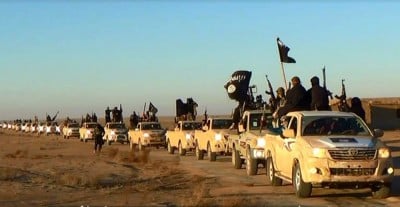Arming the Islamic State: The Problems with Backing and Arming Governments

Monsters are the stuff of legend, but they rarely exist in splendid isolation. They have reasons to be, be it by script or oral tradition. In politics, where monsters perform a theatrical necessity – they are the wicked ones who must be defeated – origins are often neglected. The evolution of various revolutionary and jihadi groups has its links to finance and rhetoric from all sides of the diplomatic round table; to backers and the punters in the Middle East and to the West. The Islamic State has proven to be no exception.
Arms may have a distinct, metallic smell, but no conscience, whatever the mystics of the National Rifle Association believe. Weapons are not spiritual, and are not reposed with the magic of miraculous wonder. They will find their way into any owner and acquirer keen to use them on targets. The recent discussions about how the Islamic State is getting both its finance and its arms is interesting only in stating an obvious point: arms and armaments will, when required, be used. There will be those who buy, and those who seize.
In the words of Fouad al-Ghuraibi, commander of the Kafr Owaid’s Martyr’s Brigade in Northern Syria, “When battling against the Syrian Army, ISIS chooses to fight in a specific battle on a specific front only when the investment is appealing: there will be warehouses to capture.”[1] IS operates as much as a combat force as it does in a financial sense: pilfer at minimum cost.
This becomes ever more acute in the chess game of supplying unstable, mutable regimes – the US efforts, for example, to arm an Iraqi army it so foolishly disarmed in the aftermath of the 2003 invasion. Having removed authoritarian regimes, only to replace them with creakily corrupt ones, the failed state syndrome has become something of a Washington sponsored pandemic through the Middle East and North Africa. Supply such regimes at your own, and the region’s, risk.
A study by the Conflict of Armament Research (CAR) of more than 1,700 shells used by Islamic State forces in the Kurdish regions of Syria and Iraq found that 20 per cent were manufactured in the United States.[2] There were other states as well – the former Soviet Union and China, Serbia, Sudan and North Korea.
The study provides a vulgar and unflattering glimpse of the arms industry spanning 21 countries. The brand name WOLF, for instance, is given to the products of the US-based Sporting Supplies International, Inc., which is also in the business of marketing Russian Federation products. In the world of armaments, there are only colleagues in purse strings and intended targets, exemplified by the fact that SSI also markets products to US civilians. Killing, in short, is both domestic and international in business and scope, and it if crudely fitting that Syrian Kurds are being killed just as US citizens are being pulverised in their own, ill-governed backyard.
More than 300 US manufactured cartridges from the 2000s were found by the CAR study. “IS forces appear to have acquired a large part of their current arsenal from stocks seized from, or abandoned by, Iraqi defence and security forces. The US gifted much of this materiel to Iraq.”
Then come such countries as Iran, with manufactured ammunition between 2006 and 2013 appearing in the samples. This has its roots, as much as anything else, in the fact that Syrian arms depots will invariably have Iranian supplied munitions. Those keen in monitoring the arms market may point to various UN Security Council resolutions restricting such a transfer but the old problem remains one of false logic. While recipients might be “vetted”, arms can, on their own accord never be. In that sense, all countries in the business are implicated.
Such vetting fictions can be found in the language of the Obama administration towards Syrian rebels, or at the very least the “right” sort of rebel Washington bureaucrats might take to tea. That plan to supply some 5,000 Syrian rebels with weapons and training in facilities in Saudi Arabia passed 273-156 in September.[3] It is governed by a bucket full of fallacies about shoring up one set of groups against another, while invariably adding more armaments to what has been described as a “dog’s breakfast” of a conflict.
It should also inspire little confidence that the Central Intelligence Agency, which has proven to be astonishingly inept in its deployments in the region, has been given that onerous, and ultimately impossible task, of vetting and anointing the fighters.
Other countries are also muscling in on the arms market, seeing chances to make decent returns even as the body bags rise in number. Sudan features prominently, providing weapons to clients in Africa and, more recently, the Middle East. Nothing grows better than a small armaments industry – cheap to make, easy to sell.
There are no morality tales to this, other than to show that the arms industry continues to be the greatest winner in the games of aspiring caliphate upstarts and moralistic democracies keen to keep revolution in check. Even as talk of stabilising and control remain on the lips of the world’s diplomats, the only real conversation taking place is that of the bullet and the shell.
Dr. Binoy Kampmark was a Commonwealth Scholar at Selwyn College, Cambridge. He lectures at RMIT University, Melbourne. Email: [email protected]
Notes:

